‘I love walking in London. Really, it’s better than walking in the country.’ Mrs Dalloway, Virginia Woolf
The books that inspired this walk…too many to mention
I worked in Bloomsbury briefly as a summer intern with Evans Educational Publishers, under the tutelage of the engaging Warren Knock, who to make ends meet or maybe just because he was a gourmand, ran his own restaurant in North London in the evenings. He liked the good things in life, and I see, looking him up on Google, that he was the publisher of ‘Beers of Britain’! I remember my little leaving do in Russell Square, within sight of where TS Eliot’s office would have been.
I bought a large black plastic dustbin, filled it with ice cubes, Pimms and lemonade and the whole office got drunk on a sunny Friday afternoon. Then Warren had to head off and cook for 60 or so…publishing often didn’t pay very much!
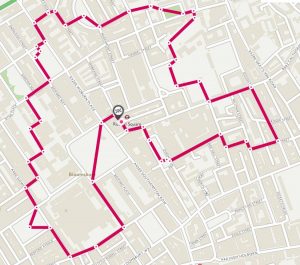
KEY DATA
- Terrain: Pavements
- Starting point: Russell Square Tube Station, WC1N 1LJ
- Distance: 4.8 km (3 miles)
- Walking time: 1 hr 12 mins, not including stops
- OS Map: The map can be found online at: https://osmaps.ordnancesurvey.co.uk/route/10404278/Bloomsbury-London
- Facilities: city facilities
If there was a beating heart at the centre of the British twentieth-century book business, it was undoubtedly Bloomsbury.
Every aspect of book publishing from inception to printing to storing and safekeeping took place here at some stage. Our journey takes us through a series of squares and areas each of which has had its special biblio-focus:
- Where people talk about writing books – Gordon Square
- Where people walk for inspiration – Virginia Woolf and Charles Dickens throughout the district
- Where books are written – Tavistock Square
- Where books are published – Bedford Square & Russell Square
- Where books are sold – Old Museum St & Great Russell St
- Where books are looked after – The British Museum
Walking for inspiration
Virginia Woolf and Charles Dickens, both inveterate walkers, would have taken many of the same routes and seen the same views as they walked through Bloomsbury. Walking was essential to their creative processes but in very different ways. Whilst Charles Dickens walked to gather ideas for his stories and was acutely attuned to the significance of his surroundings, Virginia Woolf walked essentially for reflection and seclusion, to ‘lose herself’.
Charles Dickens is estimated to have walked twelve miles per day. He confessed that ‘if I couldn’t walk fast and far, I should just explode and perish’. Throughout his life, he remained a dizzyingly energetic pedestrian, and very often his fiction is at its most extraordinary when dealing with this apparently banal and quotidian activity. Think, for instance, of the insomniac doctor Allan Woodcourt, the predatory Barnaby Rudge Senior or the melancholic Sydney Carton – in almost all of Dickens’s novels the reader finds at least one peculiar pedestrian who wanders, stalks, drifts or creeps through the streets.
He wrote a famous essay about walking, ‘Night Walks’ (1860), which he did to help cure his insomnia but also to experience what homelessness was like. ‘The wild moon and clouds were as restless as an evil conscience in a tumbled bed,’ he wrote, ‘and the very shadow of the immensity of London seemed to lie oppressively upon the river’. His essay can be read at: www.charlesdickenspage.com/night-walks.html. And there is also a good map of the route that he took.
Virginia Woolf was almost as hooked on walking as Dickens. Much of her novel Mrs Dalloway is a long walk taken by the heroine through Westminster, Trafalgar Square and Regent’s Park as she thinks about the party she is holding that evening. Her character Mrs Dalloway, perhaps the greatest flâneuse of twentieth-century literature, remarks: ‘I love walking in London. Really, it’s better than walking in the country.’
For another day, you can trace the exact route taken by Mrs Dalloway (see Other Stuff, below). This is written in the form of a stream of consciousness, focusing much more on her thoughts than the significance of the people and things around her.
A diary entry sums up neatly what she gets from walking: ‘A fine spring day. I walked along Oxford St. The buses are strung on a chain. People fight & struggle. Knocking each other off the pavement. Old bareheaded men; a motor car accident, &c. To walk alone in London is the greatest rest.’
THE WALK
We start our walk from Russell Square Tube Station and head south first to the secluded Queen Square Gardens.
Queen Square Gardens
At the south end of the gardens, there is a floral bowl and lines by Philip Larkin and Ted Hughes that commemorate the Queen’s Silver Jubilee of 1977.
William Morris lived here and set up a decorators’ shop at No. 25/26 from 1865-1871 and wrote the ‘Earthly Paradise’ here. Henry James used to be a regular visitor.
Ted Hughes and Sylvia Plath got married in the Church of St George the Martyr in the southwest corner of the square on 16 June 1956 – Bloomsday, the date being chosen for its literary associations. Ted Hughes would have come back to the square frequently from the 1970s onwards as Faber & Faber moved their offices here, to No. 3.
Great Ormond Street
Charles Dickens wrote about the children’s hospital in ‘Our Mutual Friend’ (1865) and gave fundraising readings for it.
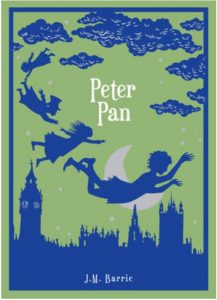 J M Barrie left the hospital with the copyright of Peter Pan in 1937, and by a special amendment to the Copyright Act, the hospital continues to receive royalties indefinitely.
J M Barrie left the hospital with the copyright of Peter Pan in 1937, and by a special amendment to the Copyright Act, the hospital continues to receive royalties indefinitely.
The Lamb Pub
Charles Dickens lived locally and is reputed to have frequented the pub, and it was also a meeting place of the Bloomsbury Group. TS Eliot would have a quick drink here too, walking out for a lunchtime break from his nearby office.
Other writers associated with the pub include Ted Hughes and Sylvia Plath. Hughes, who was a regular at the pub, arranged to meet Plath there in the early days of their relationship, and they spent their wedding night at nearby No. 18 Rugby St.
Doughty St
Before entering Doughty St, we spot the Lady Ottoline pub, no connection that we can discover though with the famous literary figure. No. 56 is the old home of The Spectator, founded in 1711.
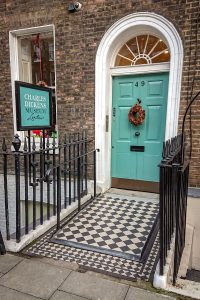 No. 48, Charles Dickens Museum: This is his only surviving London house, where he lived from 1837-1839, and completed The Pickwick Papers (1836), Oliver Twist (1838) and Nicholas Nickleby (1838–39). Notable artefacts in the museum include numerous first editions, original manuscripts and letters, and many personal items owned by him and his family.
No. 48, Charles Dickens Museum: This is his only surviving London house, where he lived from 1837-1839, and completed The Pickwick Papers (1836), Oliver Twist (1838) and Nicholas Nickleby (1838–39). Notable artefacts in the museum include numerous first editions, original manuscripts and letters, and many personal items owned by him and his family.
Coram’s Fields is on the site of the old Foundling Hospital, founded in 1739 by Captain Thomas Coram, an establishment ‘for the maintenance and education of exposed and deserted young children’.
When Dickens lived in the neighbourhood, he would have looked through these same railings to the playground beyond. He mentions Coram’s Fields in ‘Little Dorritt’, in which Harriet Beadle goes by the name of Tattycoram, having been brought up in the hospital. ‘A sullen, passionate girl, at one time she was tatty and at one time she was Coram until we got into a way of mixing the two names together and now, she is Tattycoram.’
Brunswick Square
EM Forster had his London base here from 1925-1939. No. 27, then No. 26 (both demolished).
Brunswick Square is mentioned in Jane Austen’s ‘Emma’, where the heroine’s sister Isabella boasts that ‘our part of London is so very superior to most others…we are so very airy’, being right on the edge of the town in those days.
From 1911-1912, Virginia Woolf lived at No. 38 (demolished) with her brother Adrian. They planned to turn the house into a commune for intellectuals.
Woburn Walk
Designed by architect Thomas Cubitt, this walk is one of the first examples of a pedestrian shopping street in the Georgian era.
WB Yeats, the Irish poet and dramatist, lived in Woburn Buildings (now No. 5), from 1895 to 1919. There is a metal plaque on the building.
The poet kept ‘open house’ on Monday evenings, and both Ezra Pound and TS Eliot were regular visitors. According to another guest, John Masefield, Yeats’ sitting room contained a big, dark blue lectern, on which his Kelmscott Chaucer stood between enormous candles in big blue wooden sconces.
Tavistock Square
Tavistock Square has probably had more famous books written in it than any other square in Britain, with Charles Dickens and Virginia Woolf each managing to notch up five here. They both found the view exceptionally conducive and maybe that helped inspire them.
Charles Dickens lived in Tavistock House (demolished) on the east side of the square from 1851 to 1860. It was here that he wrote ‘Bleak House’ (1853), ‘Hard Times’ (1854), ‘Little Dorritt’ (1857), A Tale of Two Cities (1859) and part of Great Expectations (1861).
He also entertained many literary friends, such as Wilkie Collins and Hans Christian Anderson, of fairy tale fame, who recalls a visit there: ‘I had a snug room looking out on the garden; and over the tree-tops I saw the London towers and spires appear and disappear as the weather cleared or thickened.’
Virginia Woolf lived at No. 52 on the south side from 1924 to 1939, during which time she wrote ‘Mrs Dalloway’ (1925), ‘To the Lighthouse’ (1927), ‘Orlando ‘(1928), ‘A Room of One’s Own’ (1929) and ‘The Waves (1931). Destroyed in the Blitz in October 1940, the site is now occupied by the Tavistock Hotel.
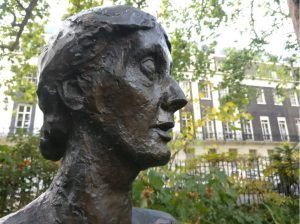 This memorial in the southwest part of the gardens was erected by the Virginia Woolf Society in 2004. Its inscription is a quote from Virginia: ‘Then one day walking round Tavistock Square I made up, as I sometimes make up my books, To the Lighthouse; in a great, apparently involuntary, rush.’
This memorial in the southwest part of the gardens was erected by the Virginia Woolf Society in 2004. Its inscription is a quote from Virginia: ‘Then one day walking round Tavistock Square I made up, as I sometimes make up my books, To the Lighthouse; in a great, apparently involuntary, rush.’
Virginia Woolf also reflects on the allure of the square in her 1930 ‘Street Haunting: A London Adventure’: ‘How beautiful a London street is then, with its islands of light, and its long gloves of darkness, and on one side of it perhaps some tree-sprinkled, grass-grown space where night is folding herself to sleep naturally and, as one passes the iron railing, one hears those little cracklings and stirrings of leaf and twig which seem to suppose the silence of fields all round them, an owl hooting, and far away the rattle of a train in the valley. But this is London, we are reminded; high among the bare trees are hung oblong frames of reddish yellow light – windows; there are points of brilliance burning steadily like low stars – lamps; this empty ground, which holds the country in it and its peace, is only a London square, set about by offices and houses.’
The square also became the home of the Hogarth Press, an enterprise the Woolfs had set up a few years earlier at their Richmond home producing hand-printed books, where they ‘bound books in the dining room, interviewed printers, bookbinders and authors in the sitting room…and printed in the larder’. Taking the upstairs rooms as their domestic quarters and devoting the cellar to the press, over the next few years – and on a shoestring – they set about publishing TS Eliot’s poetry, as well as classics by EM Forster and Katherine Mansfield, Robert Graves, H.G. Wells, and many others.
Gordon Square
Virginia Woolf lived at No. 45 from 1904 to 1907 with her sister Vanessa, after the death of their father, Sir Leslie Stephen. The house was the early focus of the now famous Bloomsbury Group, a network of artists, writers and critics, who delighted in ‘the pleasures of human intercourse and the enjoyment of beautiful things’. The name seems to have started being used, as a joke, in 1910, and then stuck, with its members becoming known as Bloomsberries.
The group included Virginia Woolf, Vita Sackville-West, Lytton Strachey, Leonard Woolf, John Maynard Keynes, Lady Ottoline Morrell, Clive Bell, EM Forster, Roger Fry, Vanessa Bell and Duncan Grant, but had no formal structure or membership. It largely followed the edict of the philosopher GE Moore that ‘one’s prime objects in life are love, the creation and enjoyment of aesthetic experience and the pursuit of knowledge’.
Woburn Square, Torrington Square, Malet St & Keppel St
Christina Rossetti (1830-1894) lived at No. 30 Torrington Square from 1859 until her death. She was most famous for Goblin Market and Other Poems which was published in 1862 and drew praise from the likes of Gerard Manley Hopkins and Lord Alfred Tennyson. We find a stone tablet in Torrington Square commemorating the poet’s life as well as a plaque by her house. We especially like her poem ‘Up-Hill’, the first stanza of which is:
Does the road wind up-hill all the way?
Yes, to the very end.
Will the day’s journey take the whole long day?
From morn to night, my friend….
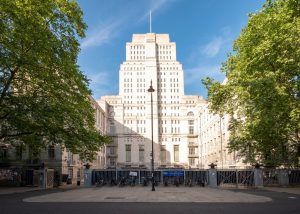 We pass the Art Deco University of London Senate House, a Ministry of Information building in WW2, which was the inspiration for George Orwell’s Ministry of Truth in ‘1984’.
We pass the Art Deco University of London Senate House, a Ministry of Information building in WW2, which was the inspiration for George Orwell’s Ministry of Truth in ‘1984’.
Anthony Trollope was born at 16 Keppel St in 1815. In his novel ‘Lady Anna’ he moves Anna and her mother into a house in Keppel Street. It is a novel about the nuances of rank and Keppel Street must have suggested to Trollope exactly the right level in the social hierarchy for this couple.
Gower St
Just across the street in Store St is where Mary Wollstonecraft (1759-1797) wrote ‘A Vindication of the Rights of Woman’ in 1791, written in six weeks while living here – it hailed equality of the sexes, railed against marriage as ‘legalised prostitution’, contested the accepted divine right of husbands and demanded ‘justice for one half of the human race’. (We see her grave on the Bournemouth walk, where she is buried with her daughter Mary Shelley, author of Frankenstein; and her memorial in St Pancras Gardens.)
The Pre-Raphaelite Brotherhood was founded in John Millais’s parents’ house at No. 7 Gower Street, London in 1848. At the first meeting, the painters John Everett Millais, Dante Gabriel Rossetti (Christina’s brother), and William Holman Hunt were present. The brotherhood deplored the imitative historical and genre painting of their day. Together they sought to revitalise art through a simpler, more positive vision.
Another famous resident of the street was Millicent Garrett Fawcett, who lived at No. 2. She led the constitutional wing of the suffragist movement from the late 1800s until victory in 1928 when women were finally given the vote. Fawcett wrote three books, perhaps her best-known being ‘Political Economy for Beginners’ (1870). She also became a founder of Newnham College, Cambridge.
Bedford Square
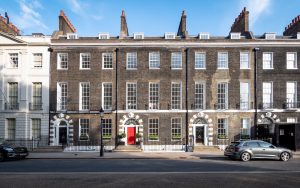
Bedford Square, which dates from 1775, was the first garden square with an imposed architectural uniformity, and it set the style for all subsequent garden squares in London.
No. 44 was home to Lady Ottoline Morrell (1873-1938), famed for the many parties she held to court the leading artistic figures of the day. Henry James, Aldous Huxley, T.S. Eliot and D.H. Lawrence all came to her house, as well as several Bloomsberries. When she first met Eliot, she found him ‘dull, dull, dull’, but they became firm friends when they discovered a mutual love of music halls and visited many together. Ottoline was much ridiculed for her flamboyant style, with scarlet platform shoes, huge hats and elaborate costumes in highly coloured velvets and brocades. She was the inspiration for Lady Hermione in D. H. Lawrence’s ‘Women in Love’, which upset her greatly and she never spoke to him again.
For much of the twentieth century, the square has been at the centre of British publishing. It no doubt has had more books published from it than any other square in history.
Scores of now-famous authors must have once paraded into this square to anxiously secure their first publishing deal, and subsequently rather grown in confidence as they became publishing sensations!
We can imagine Beatrix Potter popping into No. 8 to meet her publishers Frederick Warne & Co., dragging herself away from her beloved Lake District and her pets; or further down the road at No. 30, at the offices of Jonathan Cape, Arthur Ransome ‘tacking in’ to pitch his ‘Swallows and Amazons’ books, or Ian Fleming looking furtively behind him before revealing his manuscript from his coat, or Roald Dahl smoking his pipe, quite sure that he would be commissioned.
And then perhaps the biggest publishing sensation of them all, Joanne Rowling walking into the offices of the then-nascent Bloomsbury Publishing at No. 50 and walking out JK Rowling, and the rest is history…
The bookshop streets
The area around the British Museum, especially Great Russell St, Old Museum St and Bury Place, is filled with new and antiquarian bookshops, which we spend far too long browsing in.
We especially enjoy The London Review Bookshop at 14 Bury Place; Jarndyce Antiquarian Booksellers at 46 Great Russell Street; the Atlantis Bookshop at 49 Museum Street; and the London Antiquarian Book Arcade at 37 Great Russell St.
British Museum
Although the British Library has long since moved alongside St Pancras, The British Museum still holds some of the country’s most historic books, including the Magna Carta, the manuscripts of Beowulf, the Lindisfarne Gospels, The Canterbury Tales and a Shakespeare first folio. These are all generally on display.
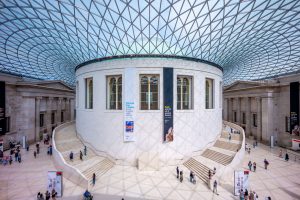 The Old Reading Room, which has been preserved, was used by many literary figures, including Oscar Wilde, Bram Stoker, Rudyard Kipling, George Orwell, George Bernard Shaw, Mark Twain, Virginia Woolf, H. G. Wells and Sir Arthur Conan Doyle.
The Old Reading Room, which has been preserved, was used by many literary figures, including Oscar Wilde, Bram Stoker, Rudyard Kipling, George Orwell, George Bernard Shaw, Mark Twain, Virginia Woolf, H. G. Wells and Sir Arthur Conan Doyle.
Virginia Woolf made reference to it in ‘A Room of One’s Own’ (1929): ‘The swing doors swung open, and there one stood under the vast dome as if one were a thought in the huge bald forehead which is so splendidly encircled by a band of famous names.’ Thomas Carlyle (1795-1881) was a little more caustic, declaring that the Reading Room was ‘a convenient asylum for imbeciles whose friends wished them out of mischief’s way’.
Russell Square
Russell Square gets a mention in Thackeray’s ‘Vanity Fair’; and, in ‘Night and Day’ Virginia Woolf places the office of her suffrage society, the ‘S.G.S.’, here. Mary Datchet works in it ‘from ten to six every day’.
TS Eliot worked for Faber & Faber at No. 24 (northwest side) for nearly forty years from 1925, first as literary adviser, then as poetry editor. The Faber book committee met each Wednesday from ‘lunch till exhaustion’ to assess manuscripts. TS Eliot famously said of his poetry brief: ‘Whereas with most categories of books you are aiming to make as much money as possible, with poetry you are aiming to lose as little as possible.’ He didn’t do too badly, publishing WH Auden, Stephen Spender, Louis MacNeice and Thom Gunn. The Hogarth Press of course was the first to publish his work.
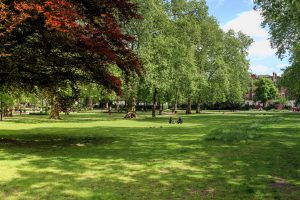 Finally, we make it, back to Russell Tube Station, stuffed full of bookish inspirations.
Finally, we make it, back to Russell Tube Station, stuffed full of bookish inspirations.
OTHER STUFF
Follow: Clarissa Dalloway’s exact route through London at http://www.virginiawoolfsociety.org.uk/resources/a-mrs-dalloway-walk-in-london/
Watch: ‘Mrs Dalloway’ (1997)
Read: Walking Virginia Woolf’s London: An Investigation in Literary Geography (2017)
Read: Virginia Woolf, Life and London, a Biography of Place (1987), by Jean Moorcroft Wilson, which includes seven walks.
Read: Walking Dickens’ London (2012), by Lee Jackson
Read: ‘Rebel Footprints’ (2015), by David Rosenburg Chapter 5: No Gods, No Masters – Radical Bloomsbury
Watch: Life in Squares, BBC (2015)

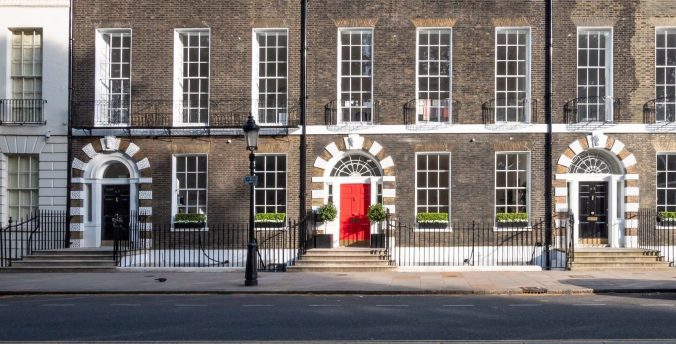
Leave a Reply